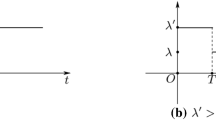Abstract
The decision-making and optimization of two-echelon inventory coordination were analyzed with service level constraint and controllable lead time sensitive to order quantity. First, the basic model of this problem was established and based on relevant analysis, the original model could be transformed by minimax method. Then, the optimal order quantity and production quantity influenced by service level constraint were analyzed and the boundary of optimal order quantity and production quantity was given. According to this boundary, the effective method and tactics were put forward to solve the transformed model. In case analysis, the optimal expected total cost of two-echelon inventory can be obtained and it was analyzed how service level constraint and safety factor influence the optimal expected total cost of two-echelon inventory. The results show that the optimal expected total cost of two-echelon inventory is constrained by the higher constraint between service level constraint and safety factor.
Similar content being viewed by others
References
PINE B. Mass customization: the new frontier in business competition [M]. Boston, USA: Harvard Business School Press, 1993: 6–8.
JHA J K, SHANKER K. Two-echelon supply chain inventory model with controllable lead time and service level constraint [J]. Computers & Industrial Engineering, 2009, 57: 1096–1104.
LIAO C J, SHYU C H. An analytical determination of lead time with normal demand [J]. International Journal of Operations & Production Management, 1991, 11: 72–78.
OUYANG L Y, YEH N C, WU K S. Mixture inventory model with backorders and lost sales for variable lead time [J]. Journal of the Operational Research Society, 1996, 47: 829–832.
MOON I, CHOI S. A note on lead time and distributional assumptions in continuous review inventory models [J]. Computers & Operations Research, 1998, 25: 1007–1012.
BEN-DAYA M, HARIGA M. Lead-time reduction in a stochastic inventory system with learning consideration [J]. International Journal of Production Research, 2003, 41: 571–579.
RYU S W, LEE K K. A stochastic inventory model of dual sourced supply chain with lead-time reduction [J]. International Journal of Production Economics, 2003, 11: 513–524.
OUYANG L Y, WU K S, HO C H. Integrated vendor buyer cooperative models with stochastic demand in controllable lead time [J]. International Journal of Production Economics, 2004, 92: 255–266.
BEN-DAYA D M, HARIGA M. Integrated single vendor single buyer model with stochastic demand and variable lead time [J]. International Journal of Production Economics, 2004, 92: 75–80.
SONG H M, YANG H, LUO J Q. Optimal ordering policy and coordination mechanism of a supply chain with controllable lead-time-dependent demand forecast [J]. Mathematical Problem in Engineering, 2011. doi: 10.155/2011/985104.
HO C H, GOYAL S K, OUYANG L Y, WU K S. An integrated vender-buyer inventory model with defective items and partial backlogging [J]. International Journal of Logistics Systems and Management, 2011, 8: 1742–7975.
CHUANG B R, OUYANG L Y, CHUANG K W. A note on periodic review inventory model with controllable setup cost and lead time [J]. Computers & Operations Research, 2004, 31: 549–561.
OUYANG L Y, CHUANG B R, LIN Y J. The inter-dependent reductions of lead time and ordering cost in periodic review inventory model with backorder price discount [J]. International Journal of Information and Management Sciences, 2007, 18: 195–208.
PAN J C, LO M C, HSIAO Y C. Optimal reorder point inventory model with variable lead time and backorder discount considerations [J]. European Journal of Operational Research, 2004, 158: 488–505.
PAN J C, HSIAO Y C. Integrated inventory models with controllable lead time and backorder discount considerations [J]. International Journal of Production Economics, 2005, 93: 387–397.
OUYANG L Y, WU K S, HO C H. An integrated vendor-buyer inventory model with quality improvement and lead time reduction [J]. International Journal of Production Economics, 2007, 108: 349–358.
PETER C, YANG K L, CHEN P S. Improved inventory models with service level and lead time [J]. Computers & Operations Research, 2005, 32: 285–296.
LIANG S K, PETER C, YANG K L. Improved periodic review inventory model involving lead-time with crashing components and service level [J]. International Journal of Systems Science, 2008, 39: 421–426.
LI Y N, XU X J, YE F. Supply chain coordination model with controllable lead time and service level constraint [J]. Computer & Industrial Engineering, 2011, 61: 858–864.
LEE W C, WU J W, LEI C L. Computational algorithmic procedure for optimal inventory policy involving ordering cost reduction and back-order discounts when lead time demand is controllable [J]. Applied Mathematics and Computation, 2007, 189: 186–200.
LIN Y J. An integrated vendor-buyer inventory model with backorder price discount and effective investment to reduce ordering cost [J]. Computers & Industrial Engineering, 2009, 56: 1597–1606.
LIN Y J. Minimax distribution free procedure with backorder price discount [J]. International Journal of Production Economics, 2008, 111: 118–128.
LI Y N, XU X J, ZHAO X D, JEFF H Y Y, YE F. Supply chain coordination with controllable lead time and asymmetric information [J]. European Journal of Operational Research, 2012, 217: 108–119.
GALLEGO G, MOON I. The distribution free newsboy problem: review and extensions [J]. Journal of the Operational Research Society, 1993, 44: 825–834.
Author information
Authors and Affiliations
Corresponding author
Additional information
Foundation item: Project(71102174, 71372019) supported by the National Natural Science Foundation of China; Project(9123028) supported by the Beijing Natural Science Foundation of China; Project(20111101120019) supported by the Specialized Research Fund for Doctoral Program of Higher Education of China; Project(11JGC106) supported by the Beijing Philosophy & Social Science Foundation of China; Projects(NCET-10-0048, NCET-10-0043) supported by the Program for New Century Excellent Talents in University of China; Project(2010YC1307) supported by Excellent Young Teacher in Beijing Institute of Technology of China
Rights and permissions
About this article
Cite this article
Li, G., Guan, X., Liu, Mq. et al. Two-echelon inventory model with service level constraint and controllable lead time sensitive to order quantity. J. Cent. South Univ. 20, 3324–3333 (2013). https://doi.org/10.1007/s11771-013-1856-5
Received:
Accepted:
Published:
Issue Date:
DOI: https://doi.org/10.1007/s11771-013-1856-5




